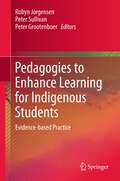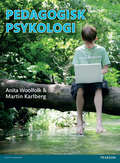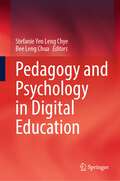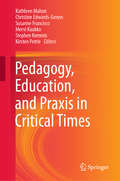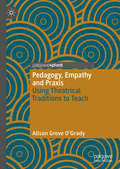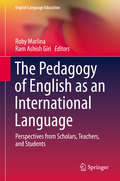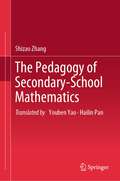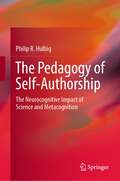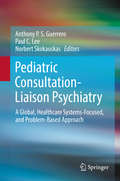- Table View
- List View
Pedagogies for Future-Oriented Adult Learners: Flipping the Lens from Teaching to Learning (Lifelong Learning Book Series #27)
by Helen Bound Jennifer Pei-Ling Tan Rebekah Lim Wei YingThis book presents a collection of chapters—both empirical and conceptual—that challenge existing paradigms of learning and teaching, provides examples of pedagogical spaces and practices that nurture future-oriented learners, explicates identities and transitions in learning, and offers alternative frames for moving forward.Educational structures have proven remarkably resilient. More often than not, pedagogical designs still privilege the lecture-tutorial format, front-end loading and the positioning of the ‘teacher’ as expert. In a similar vein, pedagogical spaces tend to privilege the formal educational institution and its discourses, rather than productively engage with naturally-occurring learning spaces at work and in communities. To better prepare and support learners for dynamically changing futures, we need to truly flip the lens from teaching to learning, positioning at the core, the learner in contexts where learning and becoming occurs. This means considering what counts as a future-oriented learner and educator, recognising the importance of evolving identities, transitions and pathways that facilitates the processes of being and becoming. Equally important is the design and appropriation of pedagogical spaces and practices that are in themselves dynamic and future-oriented. This book questions the current delineation between the spaces of work, learning and communities.
Pedagogies in the Flesh: Case Studies on the Embodiment of Sociocultural Differences in Education
by Sarah Travis, Amelia M. Kraehe, Emily J. Hood and Tyson E. LewisThis book presents a collection of vivid, theoretically informed descriptions of flashpoints––educational moments when the implicit sociocultural knowledge carried in the body becomes a salient feature of experience. The flashpoints will ignite critical reflection and dialogue about the formation of the self, identity, and social inequality on the level of the preconscious body.
Pedagogies of the Imagination: Mythopoetic Curriculum in Educational Practice
by Peter Willis Timothy LeonardI have long admired the mythopoetic tradition in curriculum studies. That admiration followed from my experience as a high-school teacher of English in a wealthy suburb of New York City at the end of the 1960s. A “dream” job—I taught four classes of 15–20 students during a nine-period day—in a “dream” suburb (where I could afford to reside only by taking a room in a retired teacher’s house), many of these often Ivy-League-bound students had everything but meaningful lives. This middle-class, Midwestern young teacher was flabbergasted. In one sense, my academic life has been devoted to understanding that searing experience. Matters of meaning seemed paramount in the curriculum field to which Paul Klohr introduced me at Ohio State. Klohr assigned me the work of curriculum theorists such as James B. Macdonald. Like Timothy Leonard (who also studied with Klohr at Ohio State) and Peter Willis, Macdonald (1995) understood that school reform was part of a broader cultural and political crisis in which meaning is but one casualty. In the mythopoetic tradition in curriculum studies, scholars labor to understand this crisis and the conditions for the reconstruction of me- ing in our time, in our schools.
Pedagogies to Enhance Learning for Indigenous Students: Evidence-based Practice
by Robyn Jorgensen, Peter Sullivan and Peter GrootenboerThis book describes research undertaken by leading Australian researcher in Indigenous communities. While the chapters are Australian in their focus, the issues that are discussed are similar to those in other countries where there are indigenous people. In most cases, in Australia and internationally, Indigenous learners are not succeeding in school, thus making the transition into work and adulthood quite tenuous in terms of mainstream measures. The importance of being literate and numerate are critical in success in school and life in general, thus making this collection an important contribution to the international literature. The collection of works describes a wide range of projects where the focus has been on improving the literacy and numeracy outcomes for Indigenous students. The chapters take various approaches to improving these outcomes, and have very different foci. These foci include aspects of literacy, numeracy, curriculum leadership, ICTs, whole school planning, policy, linguistics and Indigenous perspectives. Most of the chapters report on large scale projects that have used some innovation in their focus. The book draws together these projects so that a more connected sense of the complexities and diversity of approaches can be gleaned.
Pedagogische adviezen voor speciale kinderen: Een praktisch handboek voor professionele opvoeders, begeleiders en leerkrachten
by Trix van Lieshout Ron van DethDit boek is ontstaan vanuit vragen uit het werkveld om concrete, praktische adviezen voor de begeleiding van kinderen en jongeren met extra ondersteuningsbehoeften. Deze adviezen worden hierin uitvoerig besproken. De nadruk ligt op oplossingsgericht werken: mét jongeren zoeken naar wat al wél goed gaat, wat zij nog nodig hebben en wat voor hen goed werkt.Door zijn eenduidige structuur is het boek zowel een naslagwerk als een praktisch handboek. Bij alle probleemgebieden komen het beeld, de oorzaken, behandelingen, prognose en concrete handelingssuggesties aan de orde.Deze geheel herziene derde druk maakt gebruik van het nieuwe DSM-5 classificatiesysteem, waarbij wij ook de nadelen van etiketteren bespreken. Alle hoofdstukken zijn geactualiseerd.Het boek is geschreven voor (aankomend) orthopedagogen, psychologen, leerkrachten, intern begeleiders, (vak)docenten, zorgcoördinatoren, maatschappelijk werkers, kinder- en jeugdartsen en voor opleidingen in Hoger Beroepsonderwijs en Universiteit.Trix van Lieshout was als orthopedagoog en gezondheidszorgpsycholoog ruim 35 jaar werkzaam in het Voortgezet (Speciaal) Onderwijs. Zij schreef eerder Druk, druk, druk. Praktische tips voor de opvoeding van kinderen met ADHD. Momenteel geeft ze lezingen over pedagogisch vakmanschap. Website: www.trixvanlieshout.nlRon van Deth is psycholoog en publicist, verbonden aan het Europees Instituut voor Educatie in Driebergen. Hij was jarenlang docent in verschillende vormen van onderwijs en eindredacteur van PsychoPraktijk. Eerder schreef hij onder andere Psychiatrie: van diagnose tot behandeling en Inleiding in de psychopathologie.
Pedagogy and Psychology in Digital Education
by Stefanie Yen Leng Chye Bee Leng ChuaThis book brings together latest research which explores the intersection between educational psychology and educational technology. It consolidates contemporary research on the psychological dimension of technology-based learning, and how new learning technologies can impact learners. More specifically, it provides a better understanding of the affordances of technology-based learning, and how they impact the cognitive and affective processes of learners, facilitate new pedagogical approaches, and transform learning environments. It discusses how technology can be used to develop twenty-first-century competencies such as creativity, critical thinking, problem-solving skills, digital literacy, reflection, and lifelong learning, and explores the pitfalls, challenges and dangers therein.
Pedagogy, Education, and Praxis in Critical Times
by Kathleen Mahon Christine Edwards-Groves Susanne Francisco Mervi Kaukko Stephen Kemmis Kirsten PetrieThis book critically explores urgent questions that researchers, educators, and policy makers need to consider and address in order to better our understanding and capacity to transform education. Focusing on areas that underpin the empirical, theoretical, and strategic research of the Pedagogy, Education and Praxis (PEP) International Research Network, it discusses the following topics: the nature of educational praxis; research approaches that facilitate praxis and praxis development; changing cultural, social, political and material conditions affecting the educational practices of teachers; and how good professional practice in teaching, leading, and professional learning are understood and experienced. Presenting findings emerging from the Pedagogy, Education and Praxis research, the book raises new questions and offers new ways of thinking about the identified issues and themes in light of current educational concerns and the prevalence of neoliberal conditions being experienced in educational settings around the globe. It provides supporting evidence and illustrative examples to help readers understand important concepts, situations, and concerns, and brings together intellectual and cultural-historical traditions that, when considered in relation to each other, open up critical opportunities and ideas orienting readers towards future educational transformation.
Pedagogy, Empathy and Praxis: Using Theatrical Traditions to Teach
by Alison Grove O'GradyThis book examines the concept of empathy as an essential aspect of the teacher training curriculum, and asks how it can be taught. While there has been a steady flow of teacher education reform books in recent years, there are comparatively few that have considered change from understandings and advances developed in human rights-based practices and theatrical traditions. The author presents unique and compelling approaches to teacher training and learning, developed in conjunction with experts in theatrical and educational fields and combining both research and praxis. This pioneering book will appeal to students and scholars of education and empathy, as well as those interested in incorporating empathy into their teaching practice.
Pedagogy for Technology Education in Secondary Schools: Research Informed Perspectives for Classroom Teachers (Contemporary Issues in Technology Education)
by David Barlex P. John WilliamsThis book explores pedagogy appropriate for the secondary school technology education classroom. It covers the dimensions of pedagogy for technology with scholarly research, including information strongly related to practice. The book discusses the nature of technology courses in secondary schools across various jurisdictions and considers how they might be viewed with regard to different epistemological frameworks. The writing is informed by, but not limited to, research and strongly related to practice with acknowledged experts in the field of technology education contributing chapters supported by evidence from technology education research or other fields. The authors speculate on pedagogical possibilities in their areas of expertise in order to consider pedagogical possibilities and develop a view of where pedagogy for technology education should move and how teachers might respond in the way they develop their practice.
Pedagogy in: Rethinking Spaces and Relations (Explorations of Educational Purpose #16)
by Nellie J. Zambrana-OrtizThis personal, creative, critical work from a leading scholar of psychology is rooted in three novel concepts and aims to share critical pedagogy in the spirit of nascent potential found in the context of a colonial Puerto Rico. First comes the idea of ‘pedagogy in (e)motion’, or the emotional matrix of the teaching and learning process. Secondly, the author explores the notion of ‘street pedagogy’ as a genuine and powerful professional tool. And thirdly, the book underscores what Zambrana-Ortiz calls ‘the interconnection of the artscience within the political and biographical act of teaching’.The purpose is to inform education teaching practice with the radical framework that, like the neurosciences, believes emotions to be a vital precursor to the planning of action, the process of decision-making and the broadening of our cognitive parameters. The chapters focus on different and yet complementary dimensions of a college teaching initiative boasting a unique interplay between a transgressive narrative, reinvented methodology and authentic samples of students’ contributions to the project. Traditionally, emotional and visceral experiences have been downplayed and rejected as fundamental components of knowledge. This book makes the case for their reinstatement, and proposes that the pleasure and commitment of teaching itself can be seen as resistance given the challenging social and political context, the bureaucracy of the Puerto Rican higher education system, and the cynicism of the self-confessed cognoscenti who think that little political progress can come from within the university system. Such resistance has proved for the author a source of inspiration and has contributed to her creation and reconceptualization of approaches to critical and useful pedagogy.D edicationTo my students who inspire many stories and provoke many emotions and challenge my capacities…To Aura, Ignacio and Jaime for their unconditional love and their everyday lessons… A cknowledgmentsMany friends, mentors and colleages from the University of Puerto Rico and United States were very important pieces to my creative work. Thanks to Donaldo Macedo who encouraged the initial proposal and to Joe Kincheloe for accepting it and bringing guidance in the right moment. Colleages like Roamé Torres and Angeles Molina, from their directive positions, were extremely supportive while Sandra Macksoud, José Solís, Pedro Subirats, and Ada Prabhavat gave me guidance and constant insights in editing and translation, as well as crucial material for my narrative. Juan Vadi enhanced my graphic elements with his talent; while college mentors, current colleages, teachers, and former graduate and undergraduate students allowed me to write their stories and reflections binging fresh accents and life to the book. Thanks for ever!
The Pedagogy of Creativity
by Anna HerbertThe Pedagogy of Creativity represents a groundbreaking study linking the pedagogy of classroom creativity with psychoanalytical theories. Taking a classroom-based example of poststructuralist methodology as its starting point, Anna Herbert’s investigation explores the relationship between creativity seen in psychological activity, such as dreams, and creativity seen in the classroom, asking the following questions: What might a methodology which taps into different forms of creativity look like? Could such a methodology support current neuropsychological theories of memory and learning? What are the consequences of imaginary and symbolic orders of knowledge for the understanding of both conscious and unconscious creativity in the classroom? Exploring the ideas of a number of psychological analysts including Jacques Lacan’s four discourses, concepts of ‘the other’ and the theories of Postructuralist thinkers including Levinas, Mead and Kristeva, Herbert explains how different theories can be used to develop creativity in the classroom and surmount obstacles preventing creative environments. Clearly presenting both theoretical positions and their bearing on classroom practice, teachers at all levels will benefit from this innovative approach to creativity, as will school psychologists and all professionals interested in the links between psychoanalysis and pedagogy. Herbert clearly communicates both theoretical positions and their bearing on classroom practice. Teacher at all levels will benefit from this innovative approach to creativity, as will school psychologists and other professionals interested in the links between psychoanalysis and pedagogy.
The Pedagogy of Creativity
by Anna HerbertThe Pedagogy of Creativity represents a groundbreaking study linking the pedagogy of classroom creativity with psychoanalytical theories. Taking a classroom-based example of poststructuralist methodology as its starting point, Anna Herbert’s investigation explores the relationship between creativity seen in psychological activity, such as dreams, and creativity seen in the classroom, asking the following questions: What might a methodology which taps into different forms of creativity look like? Could such a methodology support current neuropsychological theories of memory and learning? What are the consequences of imaginary and symbolic orders of knowledge for the understanding of both conscious and unconscious creativity in the classroom? Exploring the ideas of a number of psychological analysts including Jacques Lacan’s four discourses, concepts of ‘the other’ and the theories of Postructuralist thinkers including Levinas, Mead and Kristeva, Herbert explains how different theories can be used to develop creativity in the classroom and surmount obstacles preventing creative environments. Clearly presenting both theoretical positions and their bearing on classroom practice, teachers at all levels will benefit from this innovative approach to creativity, as will school psychologists and all professionals interested in the links between psychoanalysis and pedagogy. Herbert clearly communicates both theoretical positions and their bearing on classroom practice. Teacher at all levels will benefit from this innovative approach to creativity, as will school psychologists and other professionals interested in the links between psychoanalysis and pedagogy.
The Pedagogy of English as an International Language: Perspectives from Scholars, Teachers, and Students (English Language Education #1)
by Roby Marlina Ram Ashish GiriThis volume offers insights in current theoretical discussions, observations, and reflections from internationally and regionally celebrated scholars on the theory and practice of teaching English informed by a new school of thought, English as an International Language (EIL). This volume provides readers (scholars, teachers, teacher-educators, researchers in the relevant fields) with: Knowledge of the changing paradigm and attitudes towards English language teaching from teaching a single variety of English to teaching intercultural communication and English language variation.Current thoughts on the theory of teaching English as an international language by internationally-celebrated established scholars and emergent scholars.Scholarly descriptions and discussions of how English language educators and teacher-educators translate the paradigm of English as an International Language into their existing teaching.Delineation of how this newly emerged paradigm is received or responded to by English language educators and students when it is implemented. Readers have a unique opportunity to observe and read the tensions and dilemmas that educators and students are likely to experience in teaching and learning EIL.
The Pedagogy of Secondary-School Mathematics
by Shizao ZhangThis book elucidates the principal aspects and characteristics of secondary school mathematics teaching and learning in China. It combines the cultivation of students' mathematical abilities with the improvement of teaching skills, and explores from both theory and practice to create mathematical pedagogy which has been widely recognized by experts in this field. This book presents a number of mathematics teaching principles and methods, and has been used as an important resource book for mathematics teachers’ education.
The Pedagogy of Self-Authorship: The Neurocognitive Impact of Science and Metacognition
by Philip R. HulbigThis book is a deep dive into the developmental and neurocognitive impact of metacognition and its role in self-transformation. It connects the latest science on learning, neuroplasticity, and self-development with the rich history of metacognitive educational practices, creating an educational vision capable to address difficult issues faced by modern education.This vision highlights self-regulation, self-authorship, and self-transformation as the key learning goals of a free and equitable education system. This model of education is grounded in science, problem solving and is capable of addressing the needs of a neurologically diverse humanity. Interviews from experts at Program for the Advancement of Learning (PAL) are integrated with the author autobiographical account of their transformative learning experience, to provide evidence on the effectiveness of utilizing a metacognitive pedagogy in promoting transformative learning.The book concludes with a general pedagogy of metacognitive instruction that integrates the scientific method with the development of an individual's theory of mind to induce expansive personal development and achievement. This book would be of interest to educators and scholars, as well as practitioners supporting neurodivergent students and employees, neurodiversity advocates, and critical disability studies researchers.
Pedagogy of Solidarity (Qualitative Inquiry and Social Justice)
by Paulo Freire Ana Maria Freire Walter de OliveiraFamous Brazilian educational and social theorist Paulo Freire presents his ideas on the importance of community solidarity in moving toward social justice in schools and society. In a set of talks and interviews shortly before his death, Freire addresses issues not often highlighted in his work, such as globalization, post-modern fatalism, and the qualities of educators for the 21st century. His illuminating comments are supplemented with commentaries by other well-known scholars, such as Ana Maria Araujo Freire, Walter de Oliveira, Norman Denzin, Henry Giroux, and Donaldo Macedo.
Pedagogy of Solidarity (Qualitative Inquiry and Social Justice #4)
by Paulo Freire Ana Maria Freire Walter de OliveiraFamous Brazilian educational and social theorist Paulo Freire presents his ideas on the importance of community solidarity in moving toward social justice in schools and society. In a set of talks and interviews shortly before his death, Freire addresses issues not often highlighted in his work, such as globalization, post-modern fatalism, and the qualities of educators for the 21st century. His illuminating comments are supplemented with commentaries by other well-known scholars, such as Ana Maria Araujo Freire, Walter de Oliveira, Norman Denzin, Henry Giroux, and Donaldo Macedo.
Pediatric and Adolescent Concussion: Diagnosis, Management, and Outcomes
by Jennifer Niskala Apps and Kevin D. WalterBetween the growing numbers of children and adolescents playing sports and the increased attention to head injuries by the larger sports community and the general public, pediatric concussions are emerging as a major concern. And as practitioners are seeing more young clients with head injuries, questions arise about age-appropriate assessment, diagnosis, treatment, and return to activity. Pediatric and Adolescent Concussion: Diagnosis, Management, and Outcomes offers evidence-based guidelines where few previously existed. This comprehensive volume clearly explains the effects of traumatic injury on the developing brain in sports- and non-sports-related contexts, and establishes a framework for immediate and long-term management, especially the crucial first 24 hours. Chapters provide a basic grounding in its subject with a history of concussion as a medical entity and a review of definitional and classification issues, take the reader through the steps of a neuropsychological evaluation, pinpoint post-injury issues, and offer strategies for the prevention of further or future injury. Pediatric and Adolescent Concussion: Diagnosis, Management, and Outcomes serves as both educational resource and practical framework for a wide array of professionals, including neuropsychologists, sports medicine physicians, child psychologists and psychiatrists, pediatric and family physicians, athletic trainers, social workers, and educators.
Pediatric and Adolescent Obstetrics and Gynecology (Clinical Perspectives in Obstetrics and Gynecology)
by Joseph S. Sanfilippo J. PatrickLaveryThis book covers a broad area-the problems associated with female develop ment-from the appearance of gender abnormalities in the delivery room, through the trials of pubescence, early maturation, and precocious child bearing. Experts from many diverse fields of scholarship have contributed chapters covering a wide range of subjects. The contributors have concentrated on their areas of expertise. The broad range of this book is unique; no other textbook covers as many areas. The diversity of subjects covered will help the reader (gynecologist, pediatrician, nurse, health counselor, social worker, or psy chologist) to understand both the physical and psychological problems which beset the female, from birth to adolescence. Because of the wealth of information presented, we hope that this volume will serve as a reference source and as a basis for further in-depth studies. The editors wish to express sincere thanks for the efforts "above and beyond the call of duty" on the part of many members of our staff. A special thank you to Carrie Marcell R.N., our research nurse and University of Louisville coordinator for this project, for her time and effort in putting up with the vagaries of the editors; and to Betty Jones and Linda Grear for their fine secretarial work. Special recognition is due Sue Koenig, whose patience with us in adapting the text to our word processor made our job a great deal easier.
Pediatric Anxiety Disorders
by Scott N. Compton Marianne A. Villabø Hanne KristensenPediatric Anxiety Disorders provides a critical, updated and comprehensive overview of anxiety disorders in children and adolescents based on the current state of empirical research. The book provides specific clinical recommendations which integrate new knowledge from neuroscience and innovative delivery formats for interventions. This is the first reference to examine anxiety diagnoses in accordance with the latest edition of the DSM-5, including childhood onset disorders, such as Separation Anxiety Disorder, Selective Mutism, Specific Phobia, Social Anxiety Disorder, Panic Disorder, Agoraphobia and Generalized Anxiety Disorder. The book assists clinicians in critically appraising the certainty of the evidence-base and the strength of clinical recommendations. Uses the latest edition of the Diagnostic and Statistical Manual of Mental Disorders, the DSM-5Includes the Grading of Recommendations Assessment, Development and Evaluation (GRADE) approach in assessing guideline developmentFocuses on advances in etiology, assessment and treatmentPresents new advances in our understanding of the brain behind fear and anxietyUses a stepped care approach to treatment
Pediatric Anxiety Disorders: A Clinical Guide (Current Clinical Psychiatry)
by Roma A. Vasa and Amy Krain RoyOver the past decade, significant advances in research methodology have stimulated dramatic progress in the field of child psychiatry in general, and in pediatric anxiety disorders, more specifically. Pediatric Anxiety Disorders: A Clinical Guide is a comprehensive and vital addition to the literature at an exciting time in the field of psychiatry. This state-of-the-art reference aims to bridge the most up-to-date research findings with relevant clinical perspectives, making it a unique and essential resource for established clinicians and researchers, as well as for students and trainees. The book is organized into four sections, each of which includes chapters on a specific area of interest. The first section reviews the current research regarding etiological mechanisms of pediatric anxiety. The second section provides in-depth descriptions of the anxiety disorders that affect children and adolescents. The third section summarizes the literature on empirically supported assessment tools and evidence based cognitive-behavioral and pharmacological interventions. Of special practical note, the authors of these chapters have included comprehensive summary tables that can serve as quick reference tools. The final section of the text is dedicated to understanding how anxiety manifests in two special populations, children with chronic medical illnesses and those with autism spectrum disorders. Pediatric Anxiety Disorders: A Clinical Guide is an authoritative new volume developed by a renowned collection of clinicians and researchers in the field of childhood anxiety disorders.
Pediatric Brain Stimulation: Mapping and Modulating the Developing Brain
by Donald L. Gilbert Adam KirtonPediatric Brain Stimulation: Mapping and Modulating the Developing Brain presents the latest on this rapidly expanding field that has seen an exponential growth in publications over the past 10 years. Non-invasive modalities like TMS can painlessly map and measure complex neurophysiology in real patients. Neuromodulatory applications like rTMS and tDCS carry increasingly proven therapeutic applications. Rapidly advancing technological methodologies are increasing opportunities and indications. Despite all these benefits, applications in the more plastic developing brains of children are only just emerging. This book provides a comprehensive overview of brain stimulation in children. Chapters include Transcranial Magnetic Stimulation (TMS) fundamentals, brain stimulation in pediatric neurological conditions, and invasive brain stimulation. The main audience for this research will be those interested in applying brain stimulation technologies to advance clinical research and patient care, although a wide variety of clinicians and scientist will find this to be a valuable reference on brain stimulation with specific chapters on a variety of conditions.Provides an overview of recent findings and knowledge of pediatric brain stimulation and the developing brainEdited by renowned leaders in the field of pediatric brain stimulationPresents a great resource for basic and clinical scientists and practitioners in neuroscience, neurology, neurosurgery, and psychiatry
Pediatric Consultation-Liaison Psychiatry: A Global, Healthcare Systems-Focused, and Problem-Based Approach
by Norbert Skokauskas Paul C. Lee Anthony P. GuerreroThis ambitious resource presents an inventive approach to integrating pediatric and mental health care based in comprehensive, family-centered service delivery. Its framework adds a problem-solving focus to the core principles of pediatric consultation-liaison psychiatry, emphasizing young patients’ developmental, family, and social context. An international panel of expert clinicians explores the value of the mental health component in treating complex and chronic cases across varied settings, as well as practical considerations in implementing collaborative pediatric care systemwide, including at the global level. Detailed case histories illustrate skills and traits essential to making this problem-based approach work, such as multidimensional thinking, a prevention mentality, a dedication to lifelong learning, and empathy and respect for young clients and their families. Included in the coverage: · Pediatric medicine for the child psychiatrist. · Safety issues in a general medical facility setting. · “Other medical” presentations and considerations in pediatric consultation-liaison psychiatry. · Principles of biopsychosocial formulation and interventions in the pediatric medical setting. · Preventive models for reducing major causes of morbidity and mortality in childhood. Child and adolescent psychiatrists, child and school psychologists, and physicians in pediatrics, general practice, and family medicine will welcome Pediatric Consultation-Liaison Psychiatry as both a robust training text and a blueprint for the future of children’s medicine.
Pediatric Disorders of Regulation in Affect and Behavior: A Therapist's Guide to Assessment and Treatment (ISSN)
by Georgia A. DeGangiPediatric Disorders of Regulation in Affect and Behavior, second edition is a skills-based book for mental health professionals working with children experiencing disorders of self-regulation. These children are highly sensitive to stimulation from the environment, emotionally reactive, and have difficulty maintaining an organized and calm state of being. Children with these struggles often have difficulty adapting to changing demands at home and school. The child may additionally struggle with bipolar or mood disorder, anxiety, depression, obsessive–compulsive disorder, Asperger’s syndrome, eating or sleep disorders, and/or attention-deficit disorder. This book will help professionals integrate treatment strategies that address the individual’s regulatory, sensory integration, and mental health problems. The book is organized with each chapter discussing a different form of dysregulation in eating, sleep, mood regulation, anxiety, attention, and behavioral control. Chapters begin with developmental and neurobiological underpinnings of the problem, include clinical observations, and close with diagnosis and treatment strategies. Recommended treatments integrate aspects of dialectical behavioral therapy, mind–body therapies and sensory integration techniques, and interpersonal therapy. Checklists for diagnosis and treatment planning are included at the conclusion of each chapter with an appendix of 20 skill sheets for use in treatment.Practical skill-based treatment book for mental health and occupational therapistsAddresses eating, sleep, mood, attention, and behavioral controlPresents integrated treatment using sensory integration, DBT, interpersonal therapy, and moreIncludes checklists and skill sheets for use in treatment



